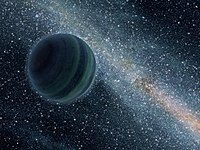Planetary objects without a planetary system
A rogue planet (also termed a free-floating planet (FFP), interstellar, nomad, orphan, starless, unbound or wandering planet) is an interstellar object of planetary-mass, therefore smaller than fusors (stars and brown dwarfs) and without a host planetary system. Such objects have been ejected from the planetary system in which they formed or have never been gravitationally bound to any star or brown dwarf.[1][2][3] The Milky Way alone may have billions to trillions of rogue planets, a range the upcoming Nancy Grace Roman Space Telescope will likely be able to narrow down.[4][5]
Some planetary-mass objects may have formed in a similar way to stars, and the International Astronomical Union has proposed that such objects be called sub-brown dwarfs.[6] A possible example is Cha 110913−773444, which may have been ejected and become a rogue planet, or formed on its own to become a sub-brown dwarf.[7]
Astronomers have used the Herschel Space Observatory and the Very Large Telescope to observe a very young free-floating planetary-mass object, OTS 44, and demonstrate that the processes characterizing the canonical star-like mode of formation apply to isolated objects down to a few Jupiter masses. Herschel far-infrared observations have shown that OTS 44 is surrounded by a disk of at least 10 Earth masses and thus could eventually form a mini planetary system.[8] Spectroscopic observations of OTS 44 with the SINFONI spectrograph at the Very Large Telescope have revealed that the disk is actively accreting matter, similarly to the disks of young stars.[8] In December 2013, a candidate exomoon of a rogue planet (MOA-2011-BLG-262) was announced.[9]
In October 2020, OGLE-2016-BLG-1928, an Earth-mass rogue planet, was discovered in the Milky Way.[10][11][12]
Observation[edit]
Artist’s conception of a Jupiter-size rogue planet.
115 potential rogue planets in the region between Upper Scorpius and Ophiuchus (2021)
Astrophysicist Takahiro Sumi of Osaka University in Japan and colleagues, who form the Microlensing Observations in Astrophysics and the Optical Gravitational Lensing Experiment collaborations, published their study of microlensing in 2011. They observed 50 million stars in the Milky Way by using the 1.8-metre (5 ft 11 in) MOA-II telescope at New Zealand’s Mount John Observatory and the 1.3-metre (4 ft 3 in) University of Warsaw telescope at Chile’s Las Campanas Observatory. They found 474 incidents of microlensing, ten of which were brief enough to be planets of around Jupiter’s size with no associated star in the immediate vicinity. The researchers estimated from their observations that there are nearly two Jupiter-mass rogue planets for every star in the Milky Way.[13][14][15] One study suggested a much larger number, up to 100,000 times more rogue planets than stars in the Milky Way, though this study encompassed hypothetical objects much smaller than Jupiter.[16] A 2017 study by Przemek Mróz of Warsaw University Observatory and colleagues, with six times larger statistics than the 2011 study, indicates an upper limit on Jupiter-mass free-floating or wide-orbit planets of 0.25 planets per main-sequence star in the Milky Way.[17]
Nearby rogue planet candidates include WISE 0855−0714 at a distance of 7.27±0.13 light-years.[18]
In September 2020, astronomers using microlensing techniques reported the detection, for the first time, of an Earth-mass rogue planet (named OGLE-2016-BLG-1928) unbounded to any star and free floating in the Milky Way galaxy.[19][20][21]
In December 2021, the largest ever group of rogue planets was discovered, numbering at least 70 and up to 170 depending on the assumed age. They are found in the OB association between Upper Scorpius and Ophiuchus with masses between 4 and 13 MJ and age around 3 to 10 million years, and were most likely formed by either gravitational collapse of gas clouds, or formation in a protoplanetary disk followed by ejection due to dynamical instabilities.[22][23][24][25]
Artist’s impression of a rogue planet by A. Stelter
Interstellar planets generate little heat and are not heated by a star.[26] However, in 1998, David J. Stevenson theorized that some planet-sized objects adrift in interstellar space might sustain a thick atmosphere that would not freeze out. He proposed that these atmospheres would be preserved by the pressure-induced far-infrared radiation opacity of a thick hydrogen-containing atmosphere.[27]
During planetary-system formation, several small protoplanetary bodies may be ejected from the system.[28] An ejected body would receive less of the stellar-generated ultraviolet light that can strip away the lighter elements of its atmosphere. Even an Earth-sized body would have enough gravity to prevent the escape of the hydrogen and helium in its atmosphere.[27] In an Earth-sized object the geothermal energy from residual core radioisotope decay could maintain a surface temperature above the melting point of water,[27] allowing liquid-water oceans to exist. These planets are likely to remain geologically active for long periods. If they have geodynamo-created protective magnetospheres and sea floor volcanism, hydrothermal vents could provide energy for life.[27] These bodies would be difficult to detect because of their weak thermal microwave radiation emissions, although reflected solar radiation and far-infrared thermal emissions may be detectable from an object that is less than 1000 astronomical units from Earth.[29] Around five percent of Earth-sized ejected planets with Moon-sized natural satellites would retain their satellites after ejection. A large satellite would be a source of significant geological tidal heating.[30]
The table below lists rogue planets, confirmed or suspected, that have been discovered. It is yet unknown whether these planets were ejected from orbiting a star or else formed on their own as sub-brown dwarfs. Whether exceptionally low-mass rogue planets (such as OGLE-2012-BLG-1323 and KMT-2019-BLG-2073) are even capable of being formed on their own is currently unknown.
Exoplanet
Mass (MJ)
Age (Myr)
Distance (ly)
Status
Discovery
OTS 44
11.5~
0.5–3
554
Likely a low-mass brown dwarf[31]
1998
S Ori 52
2–8
1–5
1,150
Age and mass uncertain; may be a foreground brown dwarf
2000[32]
S Ori 70
3
2002
Cha 110913-773444
5–15
2~
529
Candidate
2004[33]
SIMP J013656.5+093347
11-13
200~
20-22
Candidate
2006[34][35]
UGPS J072227.51−054031.2
5–40
13
Mass uncertain
2010
M10-4450
2–3
325
Candidate
2010[36]
WISE 1828+2650
3–6 or 0.5–20[37]
2–4 or 0.1–10[37]
47
2011
CFBDSIR 2149−0403
4–7
110–130
117–143
Candidate
2012[38]
WISE 0535−7500
1.5 – 8
47
2012
MOA-2011-BLG-262
4~
Likely a red dwarf
2013
PSO J318.5−22
5.5–8
21–27
72.32
Confirmed; also known as 2MASS J21140802-2251358
2013[39][40]
2MASS J2208+2921
11–13
21–27
115
Candidate; radial velocity needed
2014[41]
WISE J1741-4642
4–21
23–130
Candidate
2014[42]
WISE 0855−0714
3–10
>1,000
7.1
Age uncertain, but old due to solar vicinity object;[43] candidate even for an old age of 12 Gyrs (age of the universe is 13.7 Gyrs)
2014[44]
2MASS J12074836–3900043
11–13
7–13
200
Candidate; distance needed
2014[45]
SIMP J2154–1055
9–11
30–50
63
Age questioned[46]
2014[47]
SDSS J111010.01+011613.1
10–12
110–130
63
Confirmed
2015[48]
2MASS J11193254–1137466 AB
4–8
7–13
~90
Candidate
2016[49]
WISEA 1147
5–13
7–13
~100
Candidate
2016[50]
OGLE-2012-BLG-1323
0.007245–0.07245
Candidate; distance needed
2017[51][52][53]
OGLE-2017-BLG-0560
1.9–20
Candidate; distance needed
2017[51][52][53]
MOA-2015-BLG-337L
9.85
23,156
May be a binary brown dwarf instead
2018[54]
KMT-2019-BLG-2073
0.19
Candidate; distance needed
2020[55]
OGLE-2016-BLG-1928
0.001-0.006
30,000–180,000
Candidate
2020[56]
WISE J0830+2837
4-13
>1,000
31.3-42.7
Age uncertain, but old because of high velocity (high Vtan is indicative of an old stellar population), Candidate if younger than 10 Gyrs
2020[57]
OGLE-2019-BLG-0551
0.0242
Poorly characterized[58]
2020[58]
2MASS J0718-6415
3 ± 1
16-28
30.5
Candidate member of the Beta Pictoris moving group. Extremely short rotation period of 1.08 hours, comparable to the brown dwarf 2MASS J0348-6022.[59][60]
2021
See also[edit]
References[edit]
^ Shostak, Seth (24 February 2005). “Orphan Planets: It’s a Hard Knock Life”. Space.com. Retrieved 13 November 2020.
^ Lloyd, Robin (18 April 2001). “Free-Floating Planets – British Team Restakes Dubious Claim”. Space.com. Archived from the original on 13 October 2008.
^ “Orphan ‘planet’ findings challenged by new model”. NASA Astrobiology. 18 April 2001. Archived from the original on 22 March 2009.
^ Neil deGrasse Tyson in Cosmos: A Spacetime Odyssey as referred to by National Geographic
^ “The research team found that the mission will provide a rogue planet count that is at least 10 times more precise than current estimates, which range from tens of billions to trillions in our galaxy.” https://scitechdaily.com/our-solar-system-may-be-unusual-rogue-planets-unveiled-with-nasas-roman-space-telescope/
^ Working Group on Extrasolar Planets – Definition of a “Planet” Position Statement on the Definition of a “Planet” (IAU) Archived 16 September 2006 at the Wayback Machine
^ “Rogue planet find makes astronomers ponder theory”
^ a b Joergens, V.; Bonnefoy, M.; Liu, Y.; Bayo, A.; Wolf, S.; Chauvin, G.; Rojo, P. (2013). “OTS 44: Disk and accretion at the planetary border”. Astronomy & Astrophysics. 558 (7): L7. arXiv:1310.1936. Bibcode:2013A&A…558L…7J. doi:10.1051/0004-6361/201322432. S2CID 118456052.
^ Bennett, D.P.; Batista, V.; et al. (13 December 2013). “A Sub-Earth-Mass Moon Orbiting a Gas Giant Primary or a High Velocity Planetary System in the Galactic Bulge”. The Astrophysical Journal. 785 (2): 155. arXiv:1312.3951. Bibcode:2014ApJ…785..155B. doi:10.1088/0004-637X/785/2/155. S2CID 118327512.
^ Gough, Evan (1 October 2020). “A Rogue Earth-Mass Planet Has Been Discovered Freely Floating in the Milky Way Without a Star”. Universe Today. Retrieved 2 October 2020.
^ Mroz, Przemek; et al. (29 September 2020). “A terrestrial-mass rogue planet candidate detected in the shortest-timescale microlensing event”. The Astrophysical Journal. 903 (1): L11. arXiv:2009.12377. Bibcode:2020ApJ…903L..11M. doi:10.3847/2041-8213/abbfad. S2CID 221971000.
^ Redd, Nola Taylor (19 October 2020). “Rogue Rocky Planet Found Adrift in the Milky Way – The diminutive world and others like it could help astronomers probe the mysteries of planet formation”. Scientific American. Retrieved 19 October 2020.
^ Homeless’ Planets May Be Common in Our Galaxy Archived 8 October 2012 at the Wayback Machine by Jon Cartwright, Science Now, 18 May 2011, Accessed 20 May 2011
^ Planets that have no stars: New class of planets discovered, Physorg.com, 18 May 2011. Accessed May 2011.
^ Sumi, T.; et al. (2011). “Unbound or Distant Planetary Mass Population Detected by Gravitational Microlensing”. Nature. 473 (7347): 349–352. arXiv:1105.3544. Bibcode:2011Natur.473..349S. doi:10.1038/nature10092. PMID 21593867. S2CID 4422627.
^ “Researchers say galaxy may swarm with ‘nomad planets'”. Stanford University. 23 February 2012. Retrieved 29 February 2012.
^ P. Mroz; et al. (2017). “No large population of unbound or wide-orbit Jupiter-mass planets”. Nature. 548 (7666): 183–186. arXiv:1707.07634. Bibcode:2017Natur.548..183M. doi:10.1038/nature23276. PMID 28738410. S2CID 4459776.
^ Luhman, Kevin L.; Esplin, Taran L. (September 2016). “The Spectral Energy Distribution of the Coldest Known Brown Dwarf”. The Astronomical Journal. 152 (2). 78. arXiv:1605.06655. Bibcode:2016AJ….152…78L. doi:10.3847/0004-6256/152/3/78. S2CID 118577918.
^ Gough, Evan (1 October 2020). “A Rogue Earth-Mass Planet Has Been Discovered Freely Floating in the Milky Way Without a Star”. Universe Today. Retrieved 2 October 2020.
^ Mróz, Przemek; et al. (2020). “A Terrestrial-mass Rogue Planet Candidate Detected in the Shortest-timescale Microlensing Event”. The Astrophysical Journal Letters. 903 (1). L11. arXiv:2009.12377. Bibcode:2020ApJ…903L..11M. doi:10.3847/2041-8213/abbfad.
^ Redd, Nola Taylor (19 October 2020). “Rogue Rocky Planet Found Adrift in the Milky Way – The diminutive world and others like it could help astronomers probe the mysteries of planet formation”. Scientific American. Retrieved 19 October 2020.
^ Miret-Roig, Núria; Bouy, Hervé; Raymond, Sean N.; Tamura, Motohide; Bertin, Emmanuel; Barrado, David; Olivares, Javier; Galli, Phillip A. B.; Cuillandre, Jean-Charles; Sarro, Luis Manuel; Berihuete, Angel (22 December 2021). “A rich population of free-floating planets in the Upper Scorpius young stellar association”. Nature Astronomy. 6: 89–97. arXiv:2112.11999. Bibcode:2021arXiv211211999M. doi:10.1038/s41550-021-01513-x. ISSN 2397-3366. S2CID 245385321. See also
Nature SharedIt article link;
ESO article link
^ “ESO telescopes help uncover largest group of rogue planets yet”. European Southern Observatory. 22 December 2021. Retrieved 22 December 2021.
^ Raymond, Sean; Bouy, Núria Miret-Roig & Hervé (22 December 2021). “We Discovered a Rogues’ Gallery of Monster-Sized Gas Giants”. Nautilus. Retrieved 23 December 2021.
^ Shen, Zili (30 December 2021). “Wandering Planets”. astrobites. Retrieved 2 January 2022.
^ Raymond, Sean (9 April 2005). “Life in the dark”. Aeon. Retrieved 9 April 2016.
^ a b c d Stevenson, David J.; Stevens, C. F. (1999). “Life-sustaining planets in interstellar space?”. Nature. 400 (6739): 32. Bibcode:1999Natur.400…32S. doi:10.1038/21811. PMID 10403246. S2CID 4307897.
^ Lissauer, J. J. (1987). “Timescales for Planetary Accretion and the Structure of the Protoplanetary disk”. Icarus. 69 (2): 249–265. Bibcode:1987Icar…69..249L. doi:10.1016/0019-1035(87)90104-7. hdl:2060/19870013947.
^ Abbot, Dorian S.; Switzer, Eric R. (2 June 2011). “The Steppenwolf: A proposal for a habitable planet in interstellar space”. The Astrophysical Journal. 735 (2): L27. arXiv:1102.1108. Bibcode:2011ApJ…735L..27A. doi:10.1088/2041-8205/735/2/L27. S2CID 73631942.
^ Debes, John H.; Steinn Sigurðsson (20 October 2007). “The Survival Rate of Ejected Terrestrial Planets with Moons”. The Astrophysical Journal Letters. 668 (2): L167–L170. arXiv:0709.0945. Bibcode:2007ApJ…668L.167D. doi:10.1086/523103. S2CID 15782213.
^ Luhman, Kevin L. (10 February 2005). “Spitzer Identification of the Least Massive Known Brown Dwarf with a Circumstellar Disk”. Astrophysical Journal Letters. 620 (1): L51–L54. arXiv:astro-ph/0502100. Bibcode:2005ApJ…620L..51L. doi:10.1086/428613. S2CID 15340083.
^ Zapatero Osorio, M. R. (6 October 2000). “Discovery of Young, Isolated Planetary Mass Objects in the σ Orionis Star Cluster”. Science. 290 (5489): 103–7. Bibcode:2000Sci…290..103Z. doi:10.1126/science.290.5489.103. PMID 11021788.
^ Luhman, Kevin L. (10 December 2005). “Discovery of a Planetary-Mass Brown Dwarf with a Circumstellar Disk”. Astrophysical Journal Letters. 635 (1): L93–L96. arXiv:astro-ph/0511807. Bibcode:2005ApJ…635L..93L. doi:10.1086/498868. S2CID 11685964.
^ Artigau, Étienne; Doyon, René; Lafrenière, David; Nadeau, Daniel; Robert, Jasmin; Albert, Loïc (n.d.). “Discovery of the Brightest T Dwarf in the Northern Hemisphere”. The Astrophysical Journal Letters. 651 (1): L57. arXiv:astro-ph/0609419. Bibcode:2006ApJ…651L..57A. doi:10.1086/509146. ISSN 1538-4357. S2CID 118943169.
^ Gagné, Jonathan; Faherty, Jacqueline K.; Burgasser, Adam J.; Artigau, Étienne; Bouchard, Sandie; Albert, Loïc; Lafrenière, David; Doyon, René; Bardalez-Gagliuffi, Daniella C. (15 May 2017). “SIMP J013656.5+093347 is Likely a Planetary-Mass Object in the Carina-Near Moving Group”. The Astrophysical Journal. 841 (1): L1. arXiv:1705.01625. Bibcode:2017ApJ…841L…1G. doi:10.3847/2041-8213/aa70e2. ISSN 2041-8213. S2CID 119024210.
^ Marsh, Kenneth A. (1 February 2010). “A Young Planetary-Mass Object in the ρ Oph Cloud Core”. Astrophysical Journal Letters. 709 (2): L158–L162. arXiv:0912.3774. Bibcode:2010ApJ…709L.158M. doi:10.1088/2041-8205/709/2/L158. S2CID 29098549.
^ a b Beichman, C.; Gelino, Christopher R.; Kirkpatrick, J. Davy; Barman, Travis S.; Marsh, Kenneth A.; Cushing, Michael C.; Wright, E. L. (2013). “The Coldest Brown Dwarf (or Free-floating Planet)?: The Y Dwarf WISE 1828+2650”. The Astrophysical Journal. 764 (1): 101. arXiv:1301.1669. Bibcode:2013ApJ…764..101B. doi:10.1088/0004-637X/764/1/101. S2CID 118575478.
^ Delorme, Philippe (25 September 2012). “CFBDSIR2149-0403: a 4-7 Jupiter-mass free-floating planet in the young moving group AB Doradus?”. Astronomy & Astrophysics. 548A: 26. arXiv:1210.0305. Bibcode:2012A&A…548A..26D. doi:10.1051/0004-6361/201219984. S2CID 50935950.
^ Liu, Michael C. (10 November 2013). “The Extremely Red, Young L Dwarf PSO J318.5338-22.8603: A Free-floating Planetary-mass Analog to Directly Imaged Young Gas-giant Planets”. Astrophysical Journal Letters. 777 (1): L20. arXiv:1310.0457. Bibcode:2013ApJ…777L..20L. doi:10.1088/2041-8205/777/2/L20. S2CID 54007072.
^ Filippazzo, Joseph C.; Rice, Emily L.; Faherty, Jacqueline; Cruz, Kelle L.; Van Gordon, Mollie M.; Looper, Dagny L. (1 September 2015). “Fundamental Parameters and Spectral Energy Distributions of Young and Field Age Objects with Masses Spanning the Stellar to Planetary Regime”. The Astrophysical Journal. 810 (2): 158. arXiv:1508.01767. Bibcode:2015ApJ…810..158F. doi:10.1088/0004-637X/810/2/158. ISSN 0004-637X. S2CID 89611607.
^ Gagné, Jonathan (10 March 2014). “BANYAN. II. Very Low Mass and Substellar Candidate Members to Nearby, Young Kinematic Groups with Previously Known Signs of Youth”. Astrophysical Journal. 783 (2): 121. arXiv:1312.5864. Bibcode:2014ApJ…783..121G. doi:10.1088/0004-637X/783/2/121. S2CID 119251619.
^ Schneider, Adam C. (9 January 2014). “Discovery of the Young L Dwarf WISE J174102.78-464225.5”. Astronomical Journal. 147 (2): 34. arXiv:1311.5941. Bibcode:2014AJ….147…34S. doi:10.1088/0004-6256/147/2/34. S2CID 38602758.
^ Zapatero Osorio, M. R.; Lodieu, N.; Béjar, V. J. S.; Martín, Eduardo L.; Ivanov, V. D.; Bayo, A.; Boffin, H. M. J.; Muzic, K.; Minniti, D.; Beamín, J. C. (1 August 2016). “Near-infrared photometry of WISE J085510.74-071442.5”. Astronomy and Astrophysics. 592: A80. arXiv:1605.08620. Bibcode:2016A&A…592A..80Z. doi:10.1051/0004-6361/201628662. ISSN 0004-6361.
^ Luhman, Kevin L. (10 May 2014). “Discovery of a ~250 K Brown Dwarf at 2 pc from the Sun”. Astrophysical Journal Letters. 786 (2): L18. arXiv:1404.6501. Bibcode:2014ApJ…786L..18L. doi:10.1088/2041-8205/786/2/L18. S2CID 119102654.
^ Gagné, Jonathan (10 April 2014). “The Coolest Isolated Brown Dwarf Candidate Member of TWA”. Astrophysical Journal Letters. 785 (1): L14. arXiv:1403.3120. Bibcode:2014ApJ…785L..14G. doi:10.1088/2041-8205/785/1/L14. S2CID 119269921.
^ Liu, Michael C. (9 December 2016). “The Hawaii Infrared Parallax Program. II. Young Ultracool Field Dwarfs”. Astrophysical Journal. 833 (1): 96. arXiv:1612.02426. Bibcode:2016ApJ…833…96L. doi:10.3847/1538-4357/833/1/96. S2CID 119192984.
^ Gagné, Jonathan (1 September 2014). “SIMP J2154-1055: A New Low-gravity L4β Brown Dwarf Candidate Member of the Argus Association”. Astrophysical Journal Letters. 792 (1): L17. arXiv:1407.5344. Bibcode:2014ApJ…792L..17G. doi:10.1088/2041-8205/792/1/L17. S2CID 119118880.
^ Gagné, Jonathan (20 July 2015). “SDSS J111010.01+011613.1: A New Planetary-mass T Dwarf Member of the AB Doradus Moving Group”. Astrophysical Journal Letters. 808 (1): L20. arXiv:1506.04195. Bibcode:2015ApJ…808L..20G. doi:10.1088/2041-8205/808/1/L20. S2CID 118834638.
^ Kellogg, Kendra (11 April 2016). “The Nearest Isolated Member of the TW Hydrae Association is a Giant Planet Analog”. Astrophysical Journal Letters. 821 (1): L15. arXiv:1603.08529. Bibcode:2016ApJ…821L..15K. doi:10.3847/2041-8205/821/1/L15. S2CID 119289711.
^ Schneider, Adam C. (21 April 2016). “WISEA J114724.10-204021.3: A Free-floating Planetary Mass Member of the TW Hya Association”. Astrophysical Journal Letters. 822 (1): L1. arXiv:1603.07985. Bibcode:2016ApJ…822L…1S. doi:10.3847/2041-8205/822/1/L1. S2CID 30068452.
^ a b Becky Ferreira (9 November 2018). “Rare Sighting of Two Rogue Planets That Do Not Orbit Stars”. Motherboard. Retrieved 10 February 2019.
^ a b Jake Parks (16 November 2018). “These Two New ‘Rogue Planets’ Wander the Cosmos Without Stars”. Discover Magazine. Retrieved 10 February 2019.
^ a b Jake Parks (15 November 2018). “Two free-range planets found roaming the Milky Way in solitude”. Astronomy Magazine. Retrieved 10 February 2019.
^ “Exoplanet-catalog”. Exoplanet Exploration: Planets Beyond our Solar System. Retrieved 4 January 2021.
^ Kim, Hyoun-Woo; Hwang, Kyu-Ha; Gould, Andrew; Yee, Jennifer C.; Ryu, Yoon-Hyun; Albrow, Michael D.; Chung, Sun-Ju; Han, Cheongho; Jung, Youn Kil; Lee, Chung-Uk; Shin, In-Gu; Shvartzvald, Yossi; Zang, Weicheng; Cha, Sang-Mok; Kim, Dong-Jin; Kim, Seung-Lee; Lee, Dong-Joo; Lee, Yongseok; Park, Byeong-Gon; Pogge, Richard W. (2021). “KMT-2019-BLG-2073: Fourth Free-floating Planet Candidate with θ e < 10 μas". The Astronomical Journal. 162 (1): 15. arXiv:2007.06870. Bibcode:2021AJ....162...15K. doi:10.3847/1538-3881/abfc4a. S2CID 235445277. ^ Mróz, Przemek; Poleski, Radosław; Gould, Andrew; Udalski, Andrzej; Sumi, Takahiro; Szymański, Michał K.; Soszyński, Igor; Pietrukowicz, Paweł; Kozłowski, Szymon; Skowron, Jan; Ulaczyk, Krzysztof; Albrow, Michael D.; Chung, Sun-Ju; Han, Cheongho; Hwang, Kyu-Ha; Jung, Youn Kil; Kim, Hyoun-Woo; Ryu, Yoon-Hyun; Shin, In-Gu; Shvartzvald, Yossi; Yee, Jennifer C.; Zang, Weicheng; Cha, Sang-Mok; Kim, Dong-Jin; Kim, Seung-Lee; Lee, Chung-Uk; Lee, Dong-Joo; Lee, Yongseok; Park, Byeong-Gon; et al. (2020), "A terrestrial-mass rogue planet candidate detected in the shortest-timescale microlensing event", The Astrophysical Journal, 903 (1): L11, arXiv:2009.12377, Bibcode:2020ApJ...903L..11M, doi:10.3847/2041-8213/abbfad, S2CID 221971000 ^ Bardalez Gagliuffi, Daniella C.; Faherty, Jacqueline K.; Schneider, Adam C.; Meisner, Aaron; Caselden, Dan; Colin, Guillaume; Goodman, Sam; Kirkpatrick, J. Davy; Kuchner, Marc; Gagné, Jonathan; Logsdon, Sarah E. (1 June 2020). "WISEA J083011.95+283716.0: A Missing Link Planetary-mass Object". The Astrophysical Journal. 895 (2): 145. arXiv:2004.12829. Bibcode:2020ApJ...895..145B. doi:10.3847/1538-4357/ab8d25. S2CID 216553879. ^ a b Mróz, Przemek; et al. (2020), "A Free-floating or Wide-orbit Planet in the Microlensing Event OGLE-2019-BLG-0551", The Astronomical Journal, 159 (6): 262, arXiv:2003.01126, Bibcode:2020AJ....159..262M, doi:10.3847/1538-3881/ab8aeb, S2CID 211817861 ^ Vos, Johanna M.; Faherty, Jacqueline K.; Gagné, Jonathan; Marley, Mark; Metchev, Stanimir; Gizis, John; Rice, Emily L.; Cruz, Kelle (2022). "Let the Great World Spin: Revealing the Stormy, Turbulent Nature of Young Giant Exoplanet Analogs with the Spitzer Space Telescope". The Astrophysical Journal. 924 (2): 68. arXiv:2201.04711. doi:10.3847/1538-4357/ac4502. S2CID 245904001. ^ "The Extrasolar Planet Encyclopaedia – 2MASS J0718-6415". exoplanet.eu. Retrieved 31 January 2021. Bibliography[edit] External links[edit]





